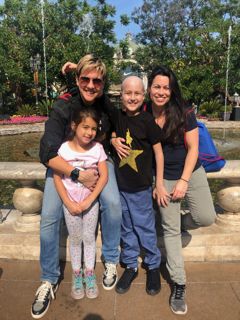Grief
The Reality of Mortality: Why We Aren't Talking About Death
Storytelling can flip the script on death and dying narratives—including yours.
Posted October 27, 2023 Reviewed by Tyler Woods
Key points
- While over 80% of pregnant Americans create a birth plan, only 22% of all Americans have a death plan.
- We aren't talking about our end-of-life desires for various reasons, but we can learn how.
- In order to normalize conversations about death and dying, we must first learn to become better listeners.
Ask any expectant mother about her “birth plan” and you’ll likely discover a great deal of thought has been given to the upcoming experience. Details outline preferences including where the monumental life event occurs, who is present, and what pain medication—if any—is administered and when. While it’s estimated that over 80 percent of the pregnant population creates a birth plan, it’s a different story at the opposite end of the life cycle. Though candidates for a “death plan” include a much larger group (the entire population), and answer many of the same questions as a birth plan, only an estimated 22 percent of Americans have documented their desires for end-of-life care.
Why We Aren't Talking About Dying
Perhaps we don’t discuss death and dying because it wasn’t modeled for us, or maybe we want to have these discussions but we don’t know how. For many, it may simply be too tender a topic. So, like a game of kick the can, we punt these tough talks, rationalizing that we’ll get to it “later.” Unfortunately, many of us never do, leaving others to decide for us—often under stressful circumstances. But it doesn't have to be this way.
As a physician and host of TED Health, Shoshana Ungerleider is committed to normalizing these conversations. During the first year of residency, Ungerleider admits she was “not prepared for the amount of suffering around the end of life,” and in witnessing discussions between doctors and patients, grew “concerned we weren’t having the conversations or having questions answered that we needed to."
To Get the Right Answers, We Need to Ask the Right Questions

According to Ungerleider, we do this by asking empowering questions that speak to a person’s values. For example, she says, asking a patient “What is your understanding of your illness?” and “How do you want to spend your time?” opens the conversation, affirms agency, and creates space for patients to engage in end-of-life decisions with dignity. Unfortunately, she says, “the systemic structure of medicine isn’t set up to have these conversations.”
So she constructed something that could.
With the belief that "improving the end-of-life experience isn’t just a medical issue—it’s a human issue," Ungerleider founded End Well in 2017. End Well is a nonprofit on a mission to transform how the world thinks about, talks about, and plans for the end of life. Its signature event is an annual day-long symposium that attracts a motley group. Among the speakers and attendees are caregivers, thought leaders, medical professionals, policymakers, and others, including one unexpected contingent recruited by Ungerleider: Hollywood.
What We Watch Shapes How We Think About Death
There is no shortage of death and dying scenes on film and TV, but Ungerleider says, “We have a long way to go in creating real imagery.” To help solve this, End Well commissioned a study that includes interviews with 30-plus television showrunners, and a 10-year script examination of keywords surrounding death, dying, grief, and loss. The full findings are expected soon, but early analysis indicates a disconnect.
Producer and showrunner J.J. Duncan agrees. After the death of her 11-year-old son Mason in 2020, Duncan recognized the need for more accurate depictions on screen as well as a societal lack of end-of-life storytelling.
“We tell our marriage stories, we tell our birth stories, we tell our career stories. Why is it taboo to tell our death stories?”
Much like the clunky conversations Ungerleider witnessed a decade ago, I suspect we're still not telling our death and dying stories very well—if at all—because we don’t know how. But, the good news is, we can learn.
The Starring Roles of Storytelling
Storytelling has two roles: the storyteller and the listener. If we’re going to normalize the sharing of our end-of-life wishes and the telling of our loved ones’ death stories, we must first create a safe space for the storyteller. The way we do that is by learning to be an active listener.
“Listening is an undervalued skill,” Duncan says. “What we need, as adults, is to be taught or re-taught and to remember the power of listening. It’s truly an unappreciated art.” Especially since, she points out, “We are narrative creatures and we have evolved through stories; from our ancestors telling stories around a fire, to gathering around radios, and then televisions, it’s how we learn, teach, and process our human experiences.”
Though expressing your end-of-life wishes or sharing about the death of your loved one may feel uncomfortable at first, doing so has many benefits. Among them is that storytelling can be a healthy way to process important emotional events and open conversation with others. Which is what happened with Duncan and her son.
Avoiding Death Discussions Doesn't Help Anyone

While undergoing treatment for an acute lymphoblastic leukemia relapse, Mason was struck by a detail written about the death of actor Chadwick Boseman that stated the movie star had "died at his home."
“This was something so far out there to him,” Duncan said. “He asked me ‘You can do that, Mama? You can die at home?'"
Three months later, Mason and his family faced the inevitable. Duncan, wife Stacey Book, and their daughter Maddie hosted a small gathering of family and friends to say goodbye. But Mason had other plans. Though his speech was strained, the 11-year-old flipped the script on his guests and "shone" telling joyful stories about each person in the room.
Mason died soon after, wrapped in the arms of his loving parents—at home—just as he wanted.
Informed by her experience and inspired by Mason, Duncan is now showrunner and executive producer of The Gentle Art of Swedish Death Cleaning (Netflix). Next month, she will join Ungerleider on the End Well stage to share her death story.
If you’re interested in creating an end-of-life plan or want to tell your death story but don’t know how, I encourage you to join in and learn more.
After all, listening to such voices may be a great first step to finding your own.
References
Waller-Wise R. Birth Plans: Encouraging Patient Engagement. J Perinat Educ. 2016;25(4):215-222. doi: 10.1891/1058-1243.25.4.215. PMID: 30643368; PMCID: PMC6310908.
Pennebaker JW, Seagal JD. Forming a story: the health benefits of narrative. J Clin Psychol. 1999 Oct;55(10):1243-54. doi: 10.1002/(SICI)1097-4679(199910)55:10<1243::AID-JCLP6>3.0.CO;2-N. PMID: 11045774.
Sarazin, Stephanie. Soulbroken: A Guidebook for Your Journey Through Ambiguous Grief. Grand Central Publishing, Balance. 2022.




